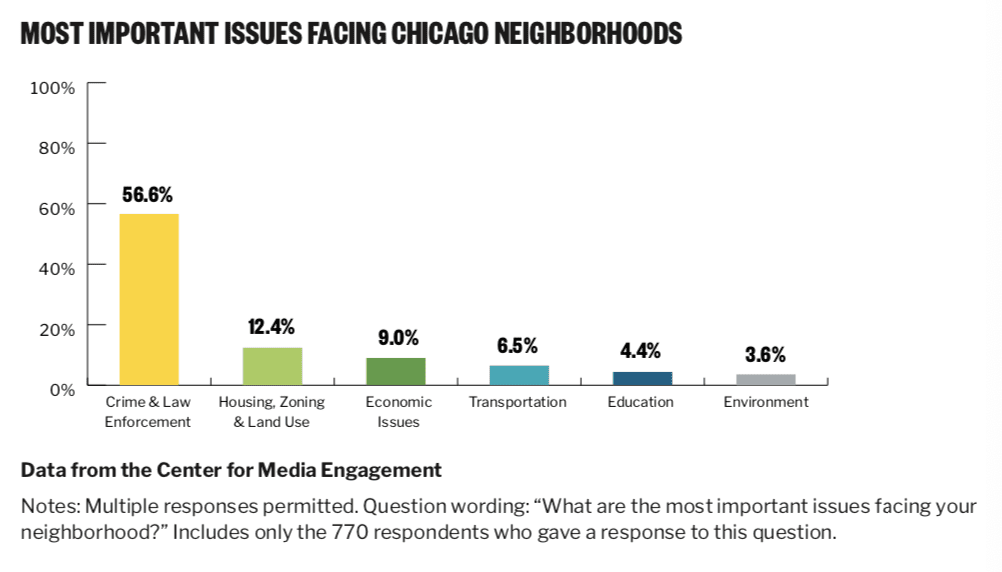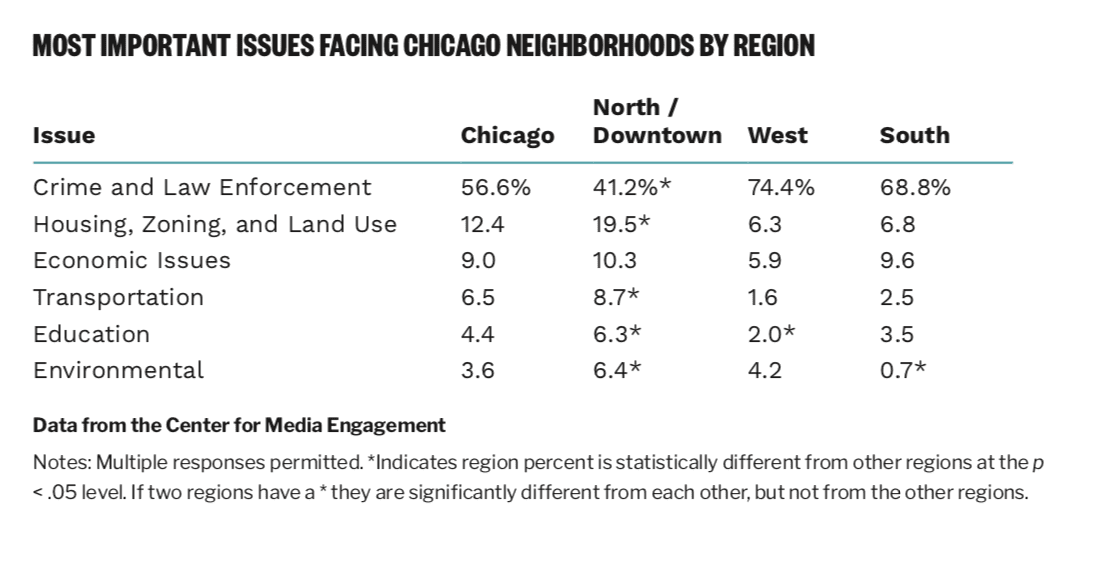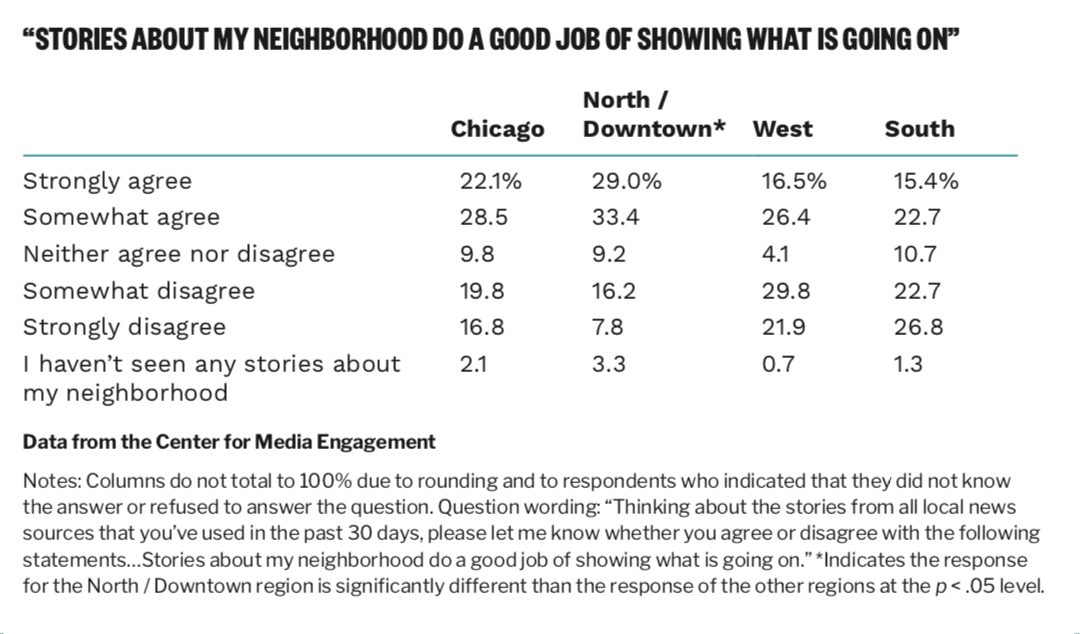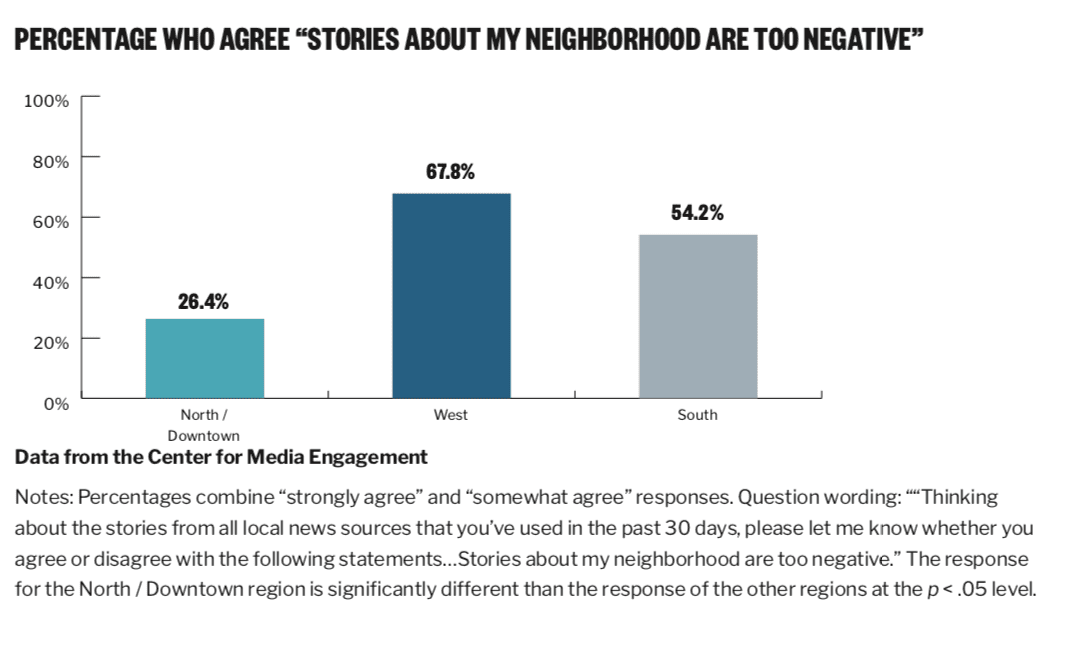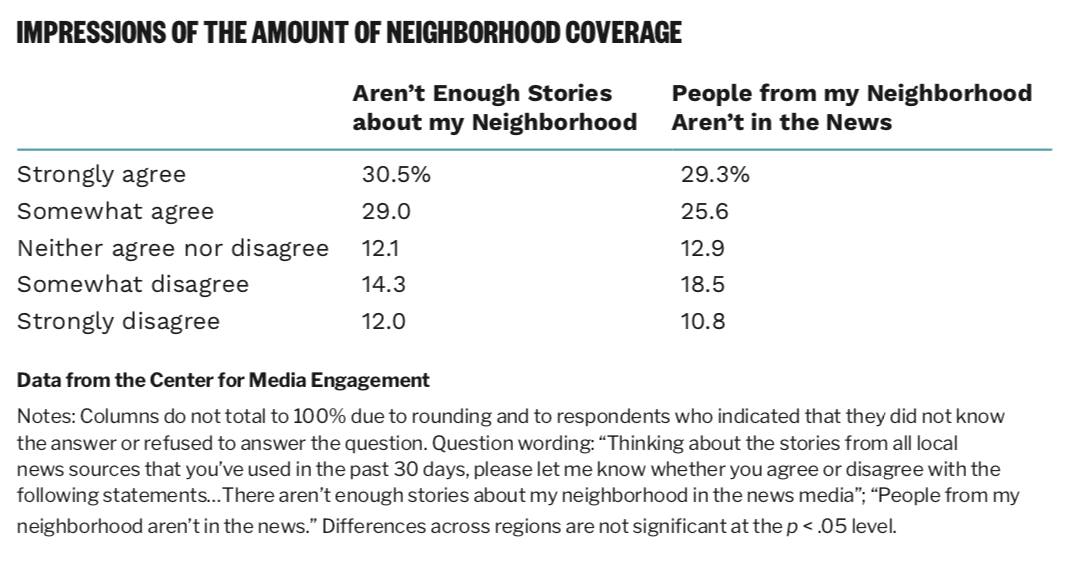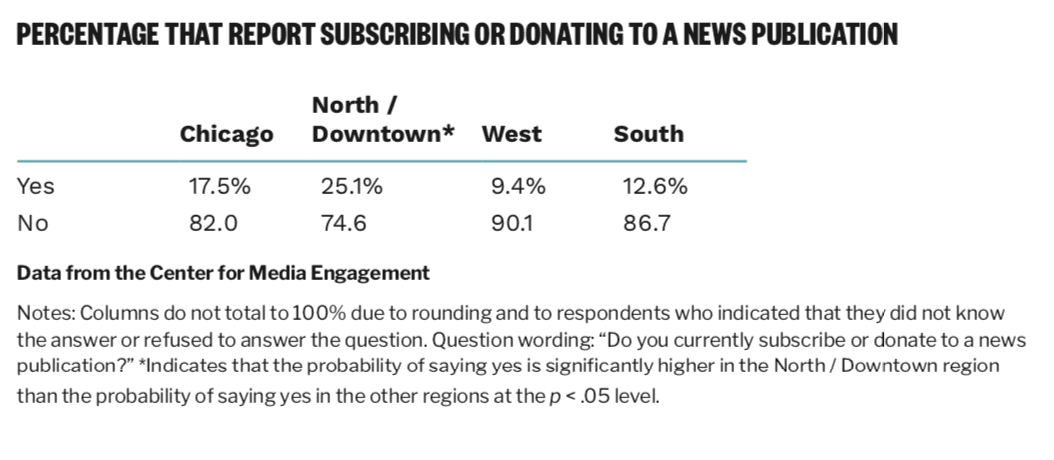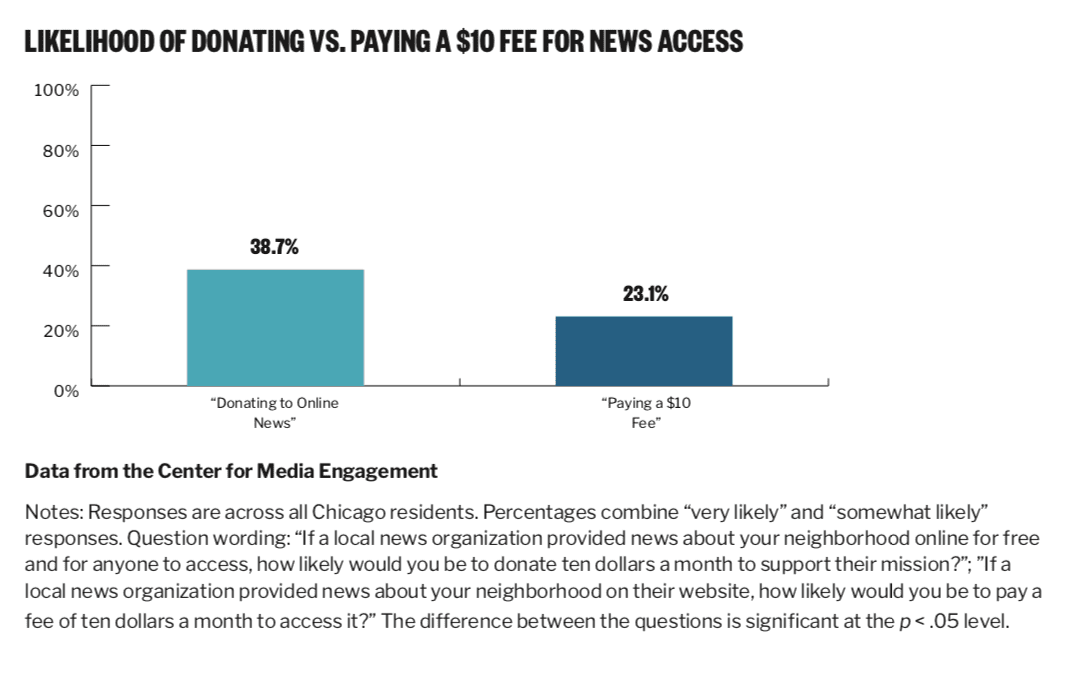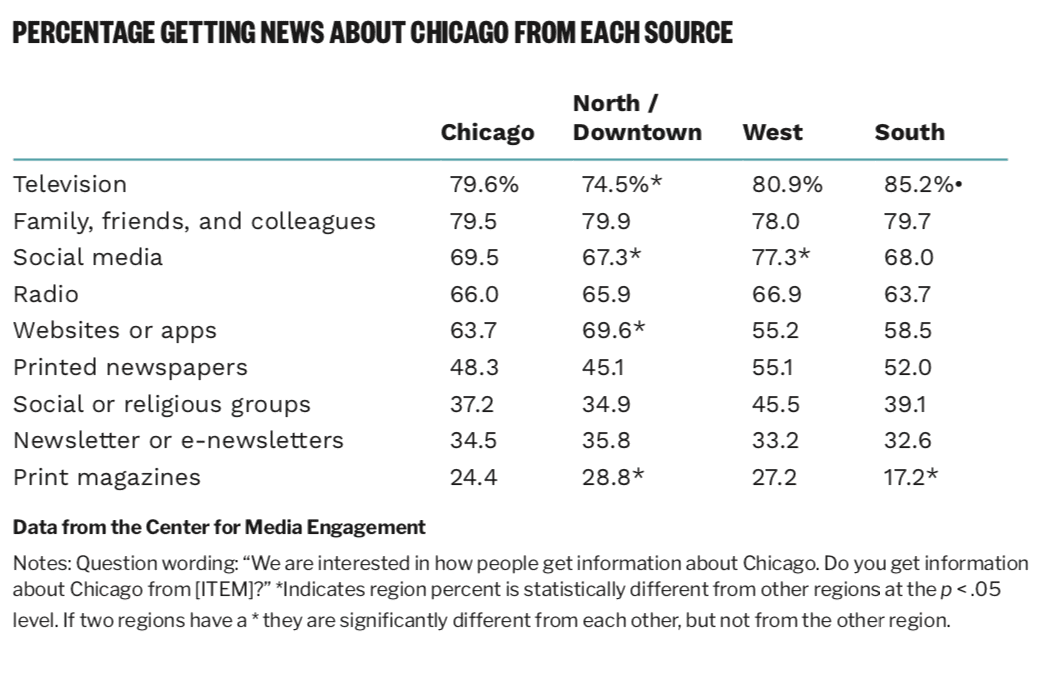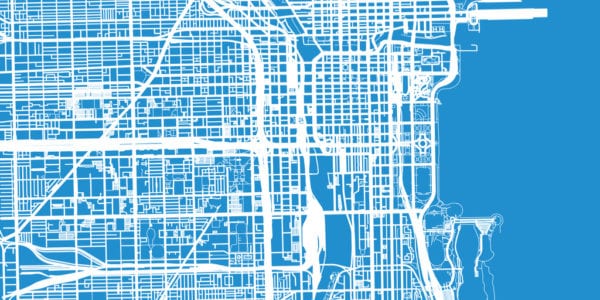
SUMMARY
The demographic diversity of Chicago is particularly notable across three regions: The North / Downtown area, the West Side, and the South Side. At the time of this study, little was known about what people in these regions thought about the Chicago news media’s coverage of their neighborhoods and coverage of issues important to them. We partnered with a local news organization, City Bureau, to explore attitudes towards, and preferences for, Chicago news media. We found that people living on the West and South Sides of Chicago generally felt underrepresented or poorly represented by Chicago news media. They were, however, the most interested in getting involved with Chicago news organizations.
IMPLICATIONS
Chicago residents have markedly different experiences with news media depending on where they live. Residents in the North / Downtown region reported more positive experiences with news media than those living on the West and South Sides. Residents in the North / Downtown region were also more likely to have communicated with a journalist and attended an event hosted by a news organization than those living on the West or South Sides. Despite these differences, West and South Side residents were more interested in volunteering with news organizations than those in the North / Downtown region.
The findings of this study, which was funded by the Robert R. McCormick Foundation, are not entirely explained by demographic differences, which suggests that location plays a distinct role in how people experience news media. Those who reported being under- and mis- represented were also the most willing to get involved, which reflects an opportunity for news organizations to engage these audiences in the future.
KEY FINDINGS
- Across all regions, Chicago residents saw “crime and law enforcement” as the most important issue facing their neighborhood.
- Chicago media have room for improvement in covering issues important to residents.
- There were big regional differences in how residents thought the news media sees their neighborhoods.
- In general, residents rated news coverage of Chicago neighborhoods as “average.”
- A majority of Chicago residents agreed that there aren’t enough stories about their neighborhood and that people from their neighborhood aren’t in the news.
- Past engagement with journalists was low, but opportunity exists to engage with audiences, especially in the West and South Sides. West and South Side residents were more interested in volunteering to report on a public meeting than North / Downtown residents were.
- Respondents were more likely to donate $10 to a free news site than pay a fee of $10 to access news.
- Some of the differences by region can be explained by demographic factors like race/ ethnicity.
- Residents in the West and South Side regions of Chicago were more likely to cite “crime and law enforcement” as an important issue facing their neighborhood than were residents in the North / Downtown region.
- North / Downtown residents thought Chicago news media offered better coverage of crime and law enforcement than residents in the West or South Side regions.
- West and South Side residents were more likely to see coverage of their neighborhoods as too negative and think that the coverage quotes the wrong people than were North / Downtown residents.
- North / Downtown residents were more likely to say coverage of their neighborhood does a good job of showing what’s going on than were West and South Side residents.
- North / Downtown residents were more likely to have communicated with a journalist or attended an event hosted by a news organization than South Side residents.
COMPLETE FINDINGS
Crime, Law Enforcement Most Important Issue Facing Chicago Neighborhoods
Overwhelmingly, Chicago residents thought the most important issue facing their neighborhood was “crime and law enforcement.” Around fifty-seven percent of Chicago residents cited “crime and law enforcement” as an important issue facing their neighborhood.
The issues that were important to residents of Chicago varied by region. Residents from the West and South Sides of Chicago were more likely to cite “crime and law enforcement” as one of the most important issues facing their neighborhoods than were North / Downtown residents.1 North / Downtown residents were more likely to say “housing, zoning, and land use” and “transportation” was more important than those in living on the West and South Sides.2 Those in the North / Downtown region also mentioned “education” as an important issue more often than those on the West Side and the “environment” more often than those on the South Side.3
Chicago Media Have Room for Improvement in Covering Important Issues
Just as there were differences in which issues were seen as important across the various Chicago regions, perceptions of how the news media cover these issues differed by region. South Side residents believed that the Chicago news media does a worse job covering the most important issue facing their neighborhood compared to North / Downtown residents.4
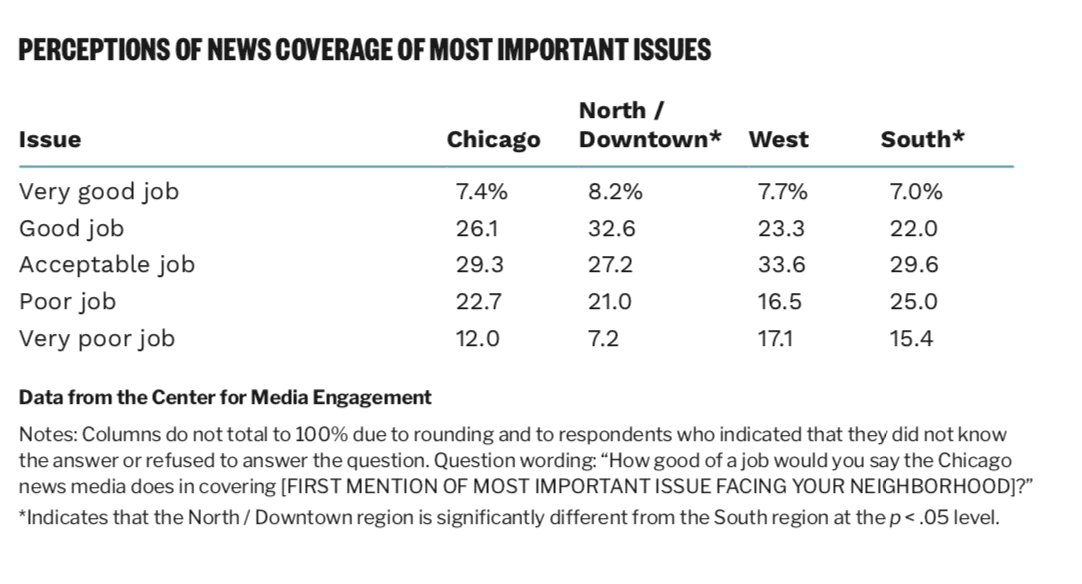 When looking only at coverage of crime and law enforcement, there were significant differences in perceptions of coverage across regions. When looking only at those who cited crime and law enforcement as the most important issue facing their neighborhood, residents in both the South and West regions said the news media do a worse job covering crime and law enforcement than those residing in the North / Downtown region.5
When looking only at coverage of crime and law enforcement, there were significant differences in perceptions of coverage across regions. When looking only at those who cited crime and law enforcement as the most important issue facing their neighborhood, residents in both the South and West regions said the news media do a worse job covering crime and law enforcement than those residing in the North / Downtown region.5
Big Regional Differences in Perception of How the News Media Sees Neighborhoods
We asked respondents to describe the way that the Chicago news media thinks about their neighborhood. Responses were markedly different in tone and topic depending on where the respondent lives. We generated word clouds based on the frequency of mentions for each word or phrase across the three regions.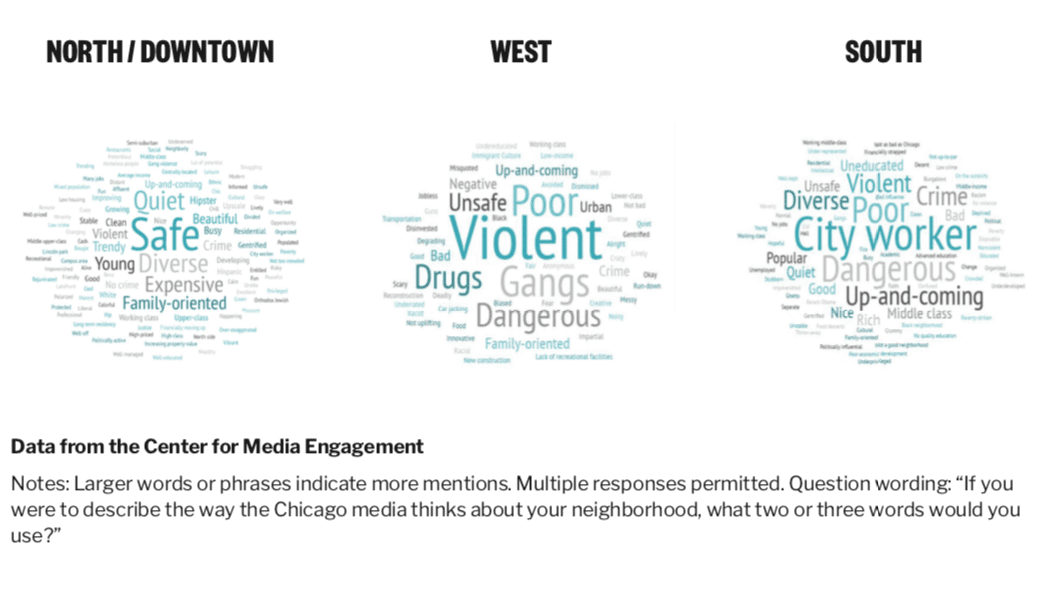
News Seen as Not Representing Neighborhoods Well, Varied by Region
Residents living on the West and South Sides were more likely to say that stories about their neighborhood quote the wrong people than were North / Downtown residents. Just over half of residents in the West (51.5%) and 41.5% percent of residents in the South agreed that stories about their neighborhood quote the wrong people compared to 27.4% of North / Downtown residents.4

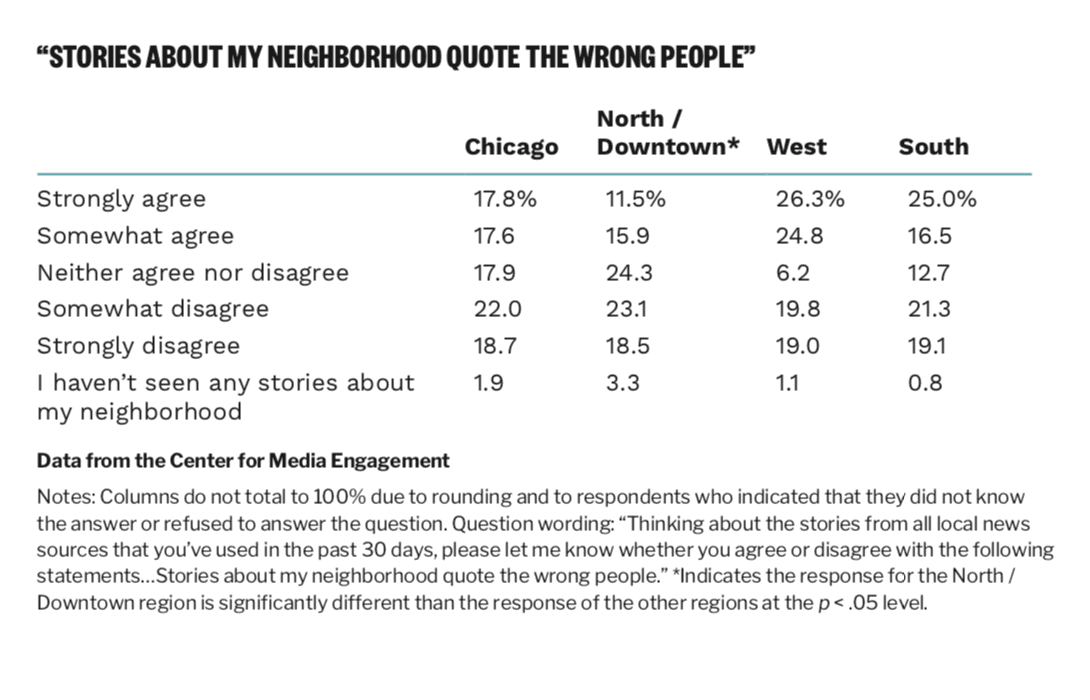 Those in the North / Downtown region were more likely to agree that stories about their neighborhood do a good job of showing what’s going on (62.4%) compared to those in the West (42.9%) and South (38.1%) Sides.6
Those in the North / Downtown region were more likely to agree that stories about their neighborhood do a good job of showing what’s going on (62.4%) compared to those in the West (42.9%) and South (38.1%) Sides.6
West Side residents were more likely to say stories about their neighborhood are too negative than were residents living in the North / Downtown. Approximately 68% of residents in the West Side and 54.2% of residents in the South Side agreed that stories about their neighborhood are too negative compared to 26.4% of residents in the North / Downtown region.7
A majority of Chicago residents agreed that there aren’t enough stories about their neighborhood (59.5%) and that people from their neighborhood aren’t in the news (54.9%). There were no significant differences among the regions on these measures of how one’s neighborhood is represented in the news.8
News Coverage of Chicago Neighborhoods “Average”
When asked to evaluate recently used news sources for whether they did a good job covering Chicago respondents’ neighborhoods, most respondents gave the news media a rating of “average.”
North / Downtown residents thought the Chicago news sources that they used recently offered better coverage of their neighborhood than did residents of the West or South Sides.4 Seventy-six percent of North / Downtown residents said coverage of their neighborhood was average or above compared to 70.8% of residents in the West Side and 65.9% of residents in the South Side.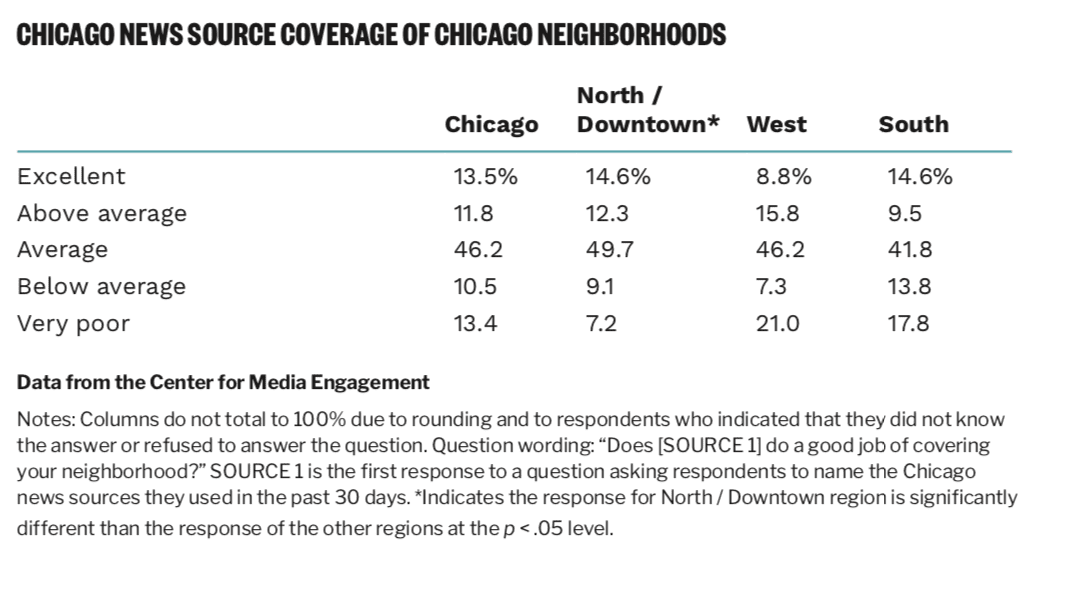
Past Journalist Engagement Low, but Opportunity Exists, Especially in the West and South Sides
Past and possible future interactions with journalists differed by region. Major differences in past communication with a journalist were between the North / Downtown and South Side regions of Chicago (Table 9). Those in the North / Downtown region were more likely to say they have communicated with a journalist in the past (29.7%) than were those in the South Side region (17.2%).9
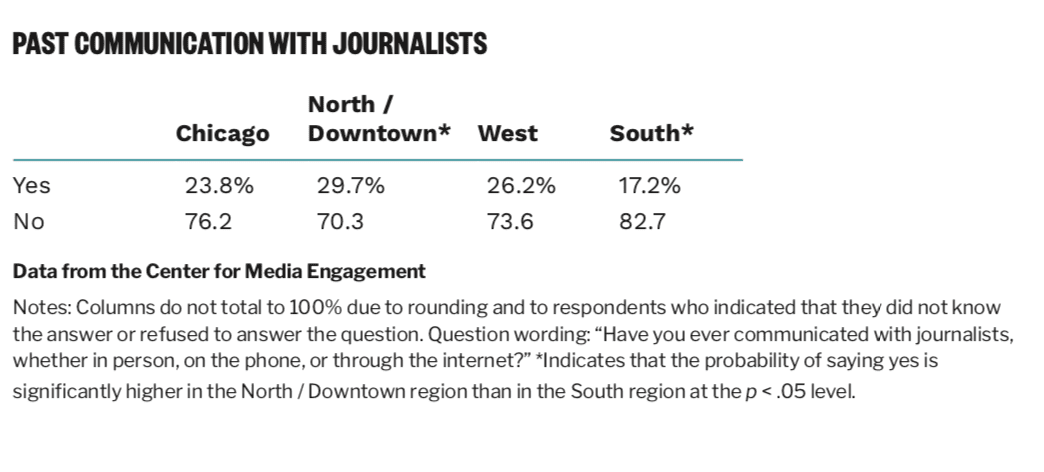 We asked respondents “How interested would you be in talking with a journalist about issues facing your neighborhood?” In response, 16.8% were very interested, 31.2% somewhat interested, 23.4% not too interested, and 27.4% not at all interested. There were no significant differences across the three regions in how they answered this question.10
We asked respondents “How interested would you be in talking with a journalist about issues facing your neighborhood?” In response, 16.8% were very interested, 31.2% somewhat interested, 23.4% not too interested, and 27.4% not at all interested. There were no significant differences across the three regions in how they answered this question.10
Overall, 15.9% said that they have been to an event hosted by a news organization at some point. Those in the North / Downtown region were more likely to have attended an event hosted by a news organization than are those living on the South Side.11
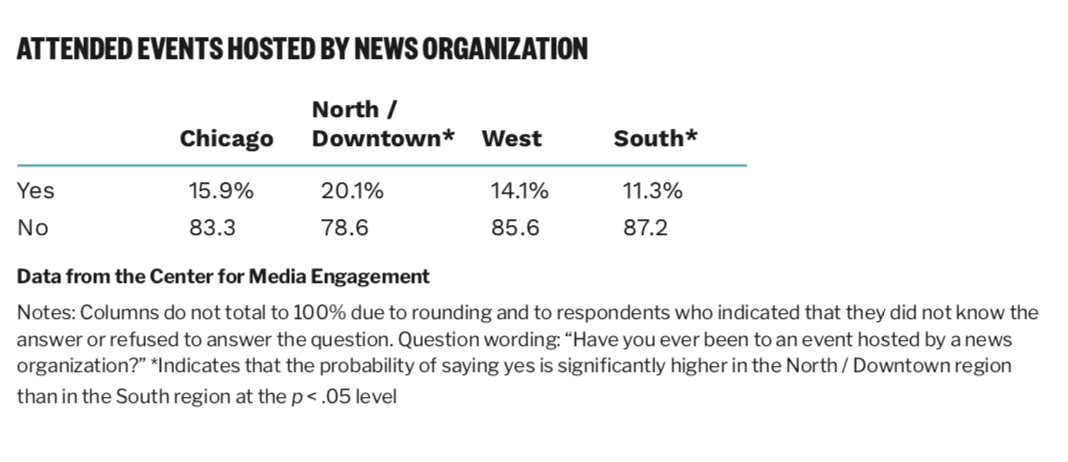 Despite differences in past interactions with journalists, West and South Side residents were more interested in volunteering to report on a public meeting than were residents in the North / Downtown region. Forty-three percent of North / Downtown residents said that they would be likely to volunteer, compared with 67.4% of West Side residents and 63.5% of South Side residents.12
Despite differences in past interactions with journalists, West and South Side residents were more interested in volunteering to report on a public meeting than were residents in the North / Downtown region. Forty-three percent of North / Downtown residents said that they would be likely to volunteer, compared with 67.4% of West Side residents and 63.5% of South Side residents.12
Many Access News, Few Pay for It
Although there were no differences across the regions in how many people use the internet at least occasionally (86.9%),9 there were differences by region in how often people access news on the internet. North / Downtown residents were more likely to access news on a desktop or laptop computer than were South Side residents. Just over half of North / Downtown residents (51.6%) said they often access news on a desktop or laptop computer compared to 39.3% of South Side residents.13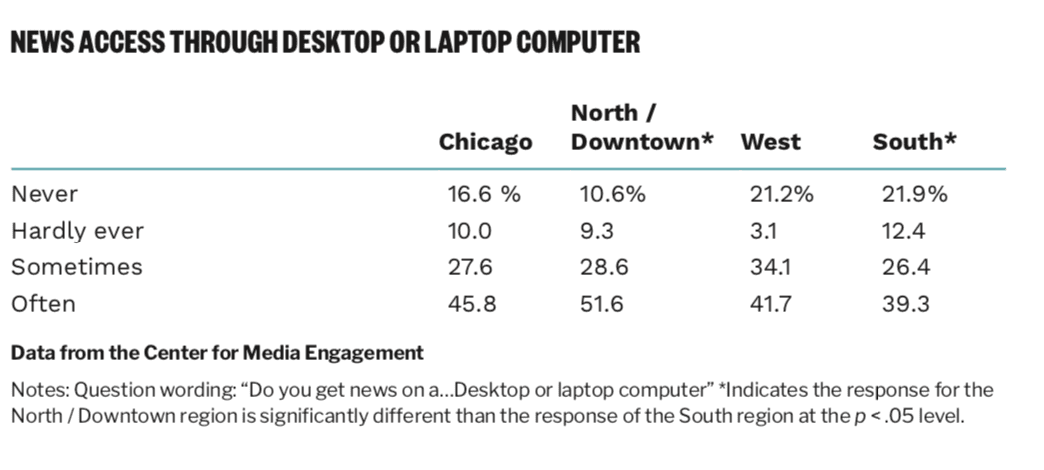 Residents in the North / Downtown region were also more likely to access news on a mobile device than were South Side residents. Nearly 70% living in the North / Downtown region said that they access news often through mobile devices compared to around 56% of those living on Chicago’s South Side.11
Residents in the North / Downtown region were also more likely to access news on a mobile device than were South Side residents. Nearly 70% living in the North / Downtown region said that they access news often through mobile devices compared to around 56% of those living on Chicago’s South Side.11
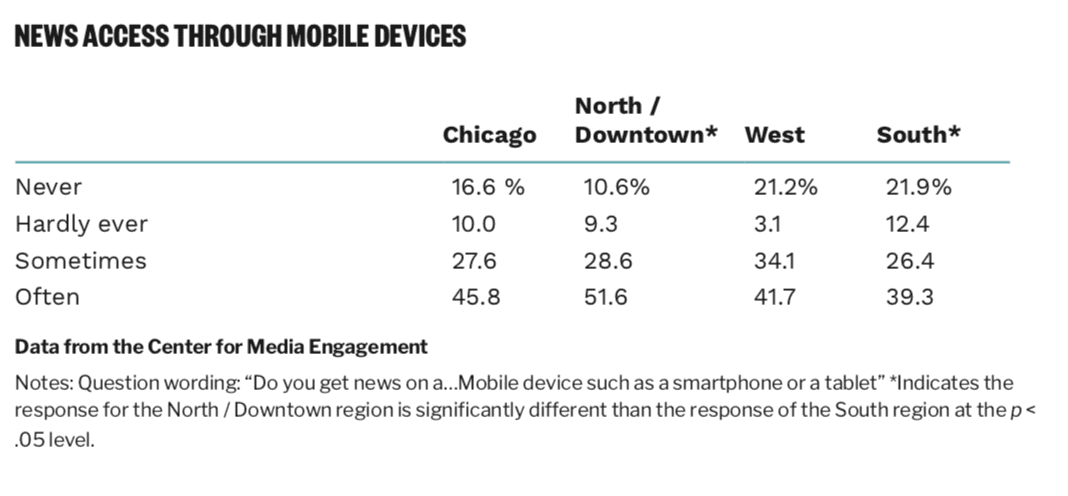 In general, few Chicago residents subscribe, or donate, to a news publication. Just under 18% of Chicago residents identified that they do so. Subscription rates differed by region. Approximately one in four North / Downtown residents said that they subscribe to a news publication compared to around one in 10 residents in the South and West Sides.9
In general, few Chicago residents subscribe, or donate, to a news publication. Just under 18% of Chicago residents identified that they do so. Subscription rates differed by region. Approximately one in four North / Downtown residents said that they subscribe to a news publication compared to around one in 10 residents in the South and West Sides.9
Asking People to “Donate” to News More Effective than “Pay a Fee”
We wanted to better understand what people think about paying for news. To do this, we contrasted two different appeals. A random half of the respondents were asked how likely they would be to donate ten dollars a month to a local news organization providing free online access to news about their neighborhood in Chicago. The other half of respondents were asked how likely they would be to pay a fee of ten dollars a month to access news about their neighborhood.
Those who received the question about donating ten dollars a month for online news that was free for anyone to access were more likely to say that they would give money than those who were asked about paying a fee of ten dollars.14 There were no differences across the regions in how likely people were to pay, regardless of whether the question asked about paying a fee or donating.15
Chicago Residents Use Diverse Media Sources
How residents receive Chicago news also differed by region. West Side residents were more likely to access news through social media (77.3%) than those from the North / Downtown (67.3%). South Side residents were most likely to access television news (85.2%) than those from the North / Downtown (74.5%).11 Residents in the North / Downtown region were more likely to access news through print magazines (28.8%) than those from the South Side (17.2%), and were more likely to access news from websites or apps (69.6%) than those on the South (58.5%) or West (55.2%) Sides.4
In terms of specific news sources, there was variability (see Methodology, Table “Top Chicago News Sources Mentioned”). The most frequently mentioned news source is the Chicago ABC News affiliate (15.2%), although CW News (12.9%) and the Chicago Tribune (12.8%) followed closely. Overall, Chicago residents use a variety of news sources.
Race and Ethnicity Affect How People Perceive, Use Chicago News Media
As evident in the analyses above, region matters to how Chicago residents interact with and perceive the Chicago news media.
There are important differences across these regions in terms of demographics. The South and West Sides, for example, are more racially diverse than the North / Downtown.
For this reason, we did an analysis to find whether media engagement differed based on: respondents’ gender, race/ethnicity, education, age, income, length of time living in Chicago, home ownership, partisanship, and the region where they live.
There were several instances in which region still mattered, even after controlling for all of the factors mentioned above. This means that there is something else about these regions that relates to people’s attitudes and behaviors, above and beyond any of the demographic and political factors we measured.
- Those in the South and West Side regions were still more likely to cite “crime and law enforcement” as an important issue facing their neighborhood than those in the North / Downtown region.
- Those in the South Side region were still more likely to agree that there aren’t enough stories about their neighborhood in the Chicago news media and that these stories are too negative compared to those in the North / Downtown and West Side regions.
- Those living on the South and West Side regions were still less likely to agree that the news media do a good job of showing what’s going on in their neighborhood compared to those living in the North / Downtown region.
- Those in the South Side were more likely to volunteer to report on a public meeting compared to those in the North / Downtown.
- Those in the South Side region were more likely to access news through a mobile device compared to those in the North / Downtown and West Side regions.
The most consistent demographic differences that relate to the questions we asked were race and ethnicity. We describe how race and ethnicity affected media engagement, even after accounting for other demographics and controlling for the region where respondents lived.16
Compared to other racial categories, Black/African-American respondents:
- Thought that the Chicago news media do a worse job covering important neighborhood issues.
- Were more likely to agree that people from their neighborhood aren’t in the news.
- Were more likely to agree that stories about their neighborhood are too negative.
- Were more likely to volunteer to report on a public meeting.
- Were more likely to access news through a desktop or laptop computer.
- Were less likely to subscribe to a news publication.
- Were more likely to say that they would donate to a news organization that provides free and open news.
Compared to non-Hispanic residents, Hispanic respondents:
- Were more likely to agree that there aren’t enough stories about their neighborhood in the Chicago news media.
- Were more likely to access news through a desktop or laptop computer.
- Were less likely to subscribe to a news publication.
- Were more likely to say that they would pay a fee of $10 to access local news.
- Were more likely to say that they would donate $10 to a news organization that provides free and open news.
- Were more likely to feel that they can’t influence the government in Chicago.
Overall, it appears that differences in responses across region were not entirely explained by prominent demographic differences such as race and ethnicity, although there were instances where these factors did matter. It is important to note that differences by region may be an interaction between several factors. For example, region and race may explain differences when taken together. Future work should look to further understand these regional differences.
METHODOLOGY
The survey of 900 Chicago residents was fielded by Abt. Associates between July 18 and August 23, 2017. The firm used random digit dialing (RDD) to complete 312 landline interviews and both RDD and a targeted list sample of Chicago residents with out-of-area cell phones to complete 588 cell phone interviews. Surveys were conducted in both English and Spanish. We used a stratified random sample to gather sufficient sample from three different regions of Chicago (North / Downtown, unweighted n=312; South Side, unweighted n=287; and West Side, unweighted n=249).17 Respondents were categorized into regions based on their zip code. Some zip codes, however, crossed regions. When this occurred, or when respondents were unsure of their zip code, region was determined by other information provided by the respondents, including cross streets and descriptions of where they lived in relation to major roadways. The regions and zip codes were categorized as follows: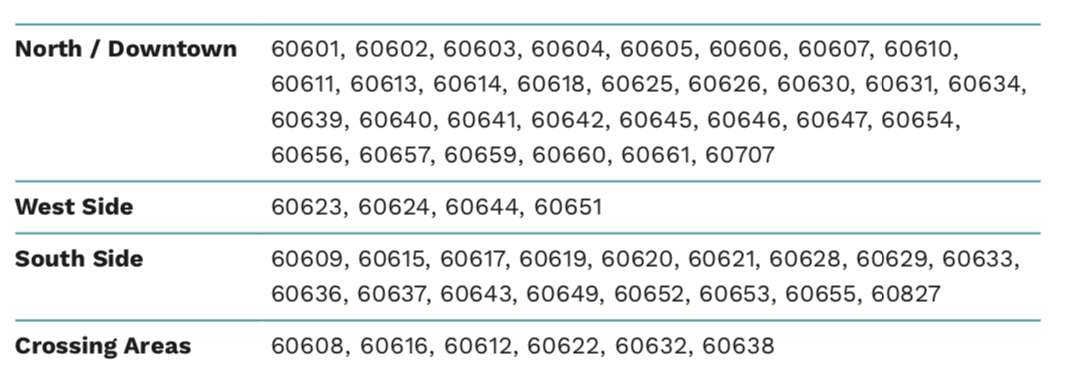
To ensure our sample reflected the population of Chicago based on various demographics, survey weights were constructed and applied to the results presented below. The combined sample is weighted to match demographic parameters from the American Community Survey and telephone status parameters from the National Health Interview Survey. The weighting procedure also accounted for the fact that respondents with both a landline and cell phone had a greater probability of selection. The margin of sampling error for weighted estimates based on the full sample is ± 4.4 percentage points. Estimates based on subgroups have larger margins of error. It is important to remember that random sampling error is only one possible source of error in a survey estimate. Other sources, such as question wording and reporting inaccuracy, may contribute additional error.
The response rate (AAPOR3) was 6.8% for the landline sample, 10.3% for the cell phone random digit dial sample, and 13.0% for the targeted cell sample of Chicago residents with out-of-area cell phones. For this survey, the design effect is 1.83.
We went through several iterations, and consulted with City Bureau and several Chicago residents to develop our final categorization of the three regions. One question we debated was whether the North Side and Downtown / The Loop should be combined. We looked at differences in responses for the North / Downtown region when removing those who live inside The Loop (zip codes: 60602; 60603; 60604; 60605; 60606; 60610; 60611; 60654; 60610; 60607). Few of our respondents resided in these areas (unweighted n=33). Inspection of the results excluding residents from The Loop revealed minimal differences.
For the most important issues question, respondents could give up to three important issues facing their neighborhood. We coded open-ended responses into one of 15 categories taken from the Policy Agendas Project,18 including a category for responses that were not related to policy and those who gave no response. Percentages were calculated based on the number of people who mentioned a category, excluding those who gave no response.
For the question asking which Chicago news sources respondents had used in the past 30 days, respondents were provided response options of 23 different news organizations.19 Respondents could also specify a different news organization not on the list, respond that they do not receive any news, respond that they did not know, or refuse to answer the question. Respondents could mention up to 10 news sources. Responses were grouped into total number of mentions for each news source.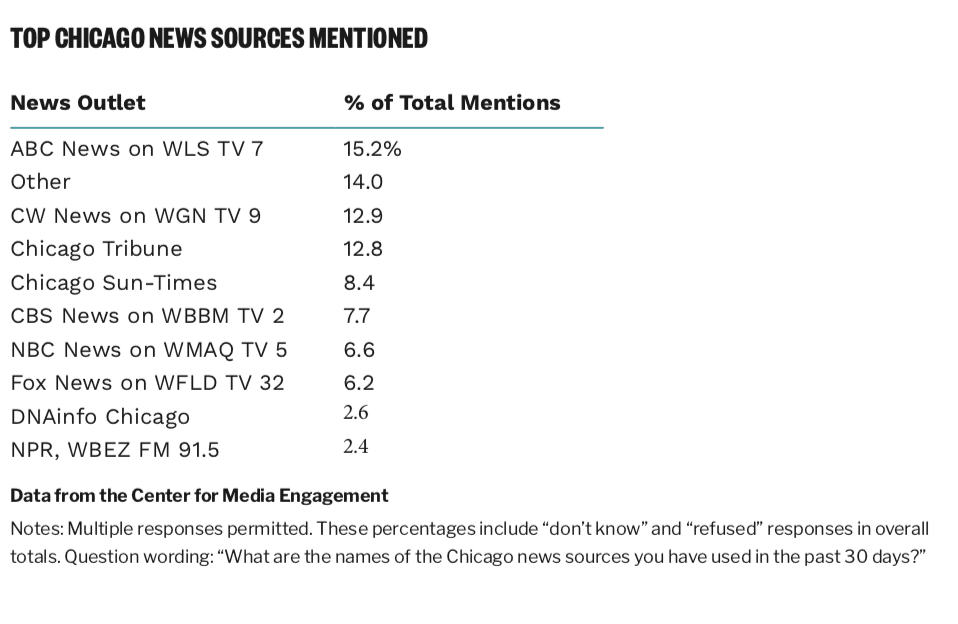 In the following tables, we included responses for all of Chicago and by region for measures of respondents’ political participation and political efficacy.
In the following tables, we included responses for all of Chicago and by region for measures of respondents’ political participation and political efficacy.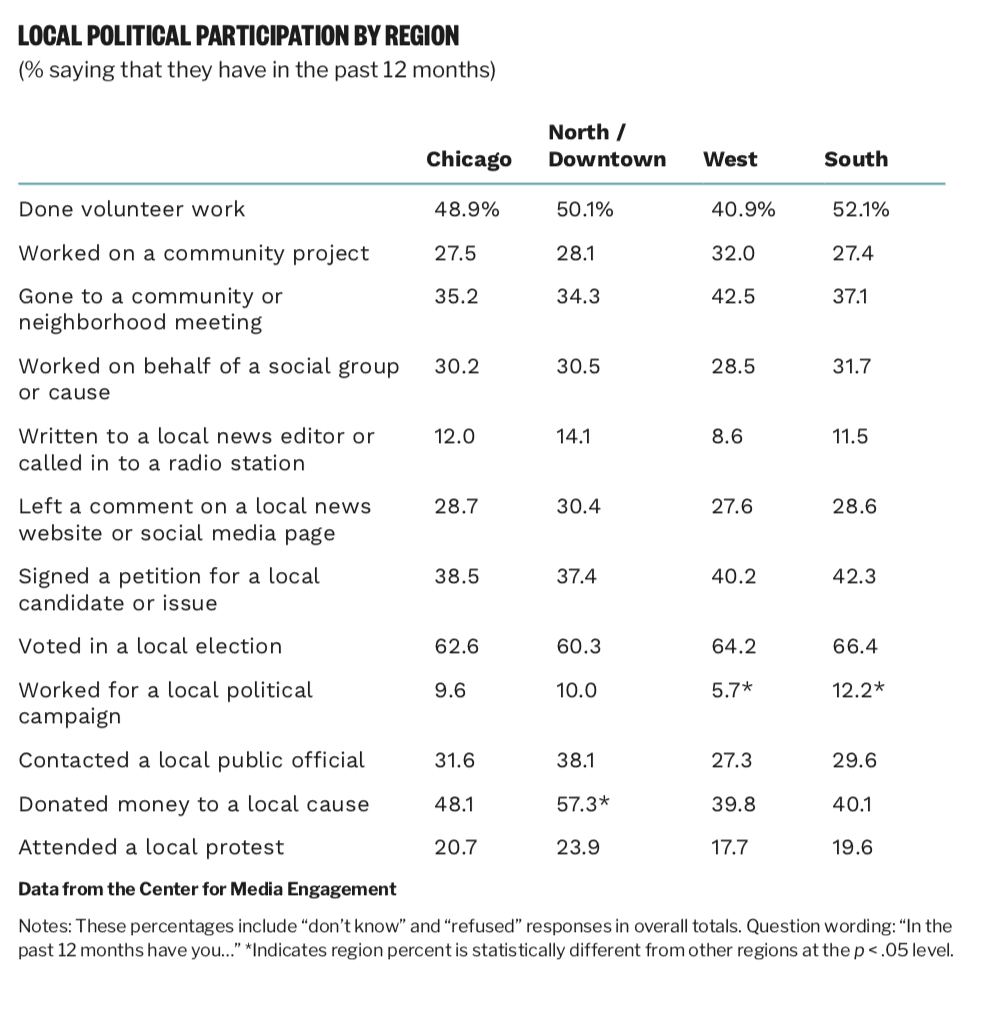

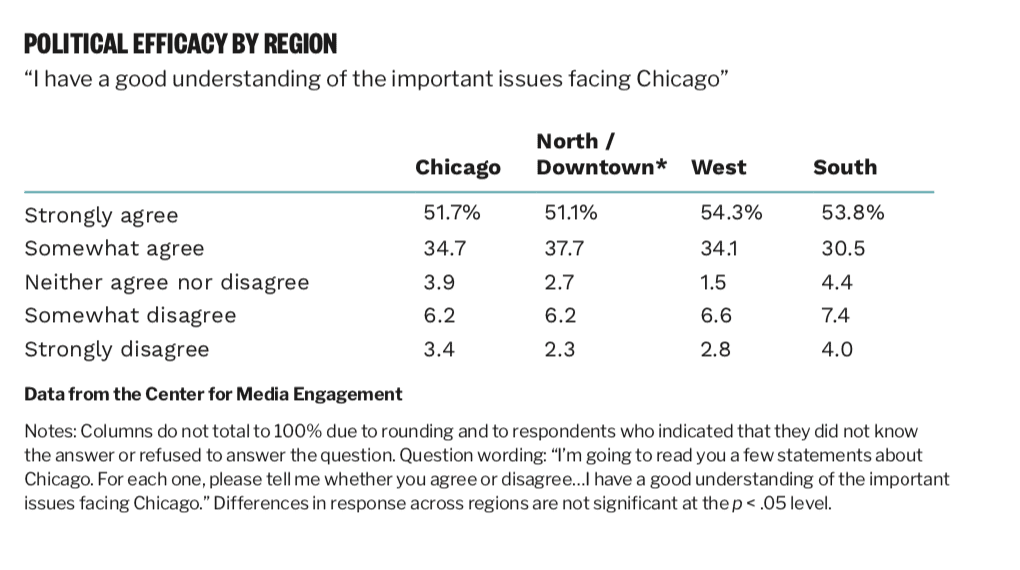
Suggested Citation:
Van Duyn, Emily, Jennings, Jay, and Stroud, Natalie Jomini. (2018, January). Chicago news landscape. Center for Media Engagement. https://mediaengagement.org/research/chicago-news-landscape
- Weighted logistic regression analysis was used to test significant differences across region in naming responses coded as law and crime issues as the most important problem. [↩]
- Weighted logistic regression analysis was used to test significant differences across regions in naming responses coded as housing issues as the most important problem. [↩]
- Weighted logistic regression analysis was used to test significant differences across regions in naming responses coded as education issues as the most important problem. [↩]
- Weighted regression analysis was used to test significant differences across region. R² for model = .02. [↩][↩][↩][↩]
- Weighted regression analysis was used to test significant differences across region. R² for model = .05. [↩]
- Weighted regression analysis was used to test significant differences across region. R² for model = .08. [↩]
- Weighted regression analysis was used to test significant differences across region. R² for model = .13. [↩]
- Weighted regression showed no differences by region. R² for both models < .001. [↩]
- Weighted logistic regression analysis was used to test significant differences across region. [↩][↩][↩]
- Weighted regression analysis was used to test significant differences across region. R² for model < .001. [↩]
- Weighted regression analysis was used to test significant differences across region. R² for model = .01. [↩][↩][↩]
- Weighted regression analysis was used to test significant differences across region. R² for model = .04. [↩]
- Weighted regression analysis was used to test significant differences across region. R² for model = .03.[↩]
- Weighted regression analysis was used to test significant differences based on the “donating” or “fee” question wording. R² for model = .05. [↩]
- Weighted regression analysis was used to test significant differences across region for both versions of the question. R² for “donating” model = .02. R² for “fee” model < .001. [↩]
- We are happy to provide the full dataset and tables upon request. [↩]
- For the remaining 52 respondents, we were unable to categorize them by region because they preferred not to share their zip code, we were unable to determine the region based on the cross-streets mentioned, or they named a zip code not included in the targets below. We include these respondents in our overall Chicago estimates. [↩]
- Baumgartner, F. R., & Jones, B. D. (2010). Agendas and instability in American politics. University of Chicago Press. [↩]
- News organizations listed were: ABC News on WLS TV 7, CW News on WGN TV 9, Chicago Tribune, Chicago Sun-Times, CBS News on WBBM TV 2, NBC News on WMAQ TV 5, Fox News on, WFLD TV 32, DNAinfo Chicago, NPR, WBEZ FM 91.5, PBS, WTTW TV 11, RedEye Chicago, Chicago Reader, Crain’s Chicago Business, Chicago Magazine, Chicago Defender, City Bureau, The Daily Herald, Windy City Times, Chicagoist, South Side Weekly, The Chicago Reporter, Time-Out Chicago Magazine. [↩]





